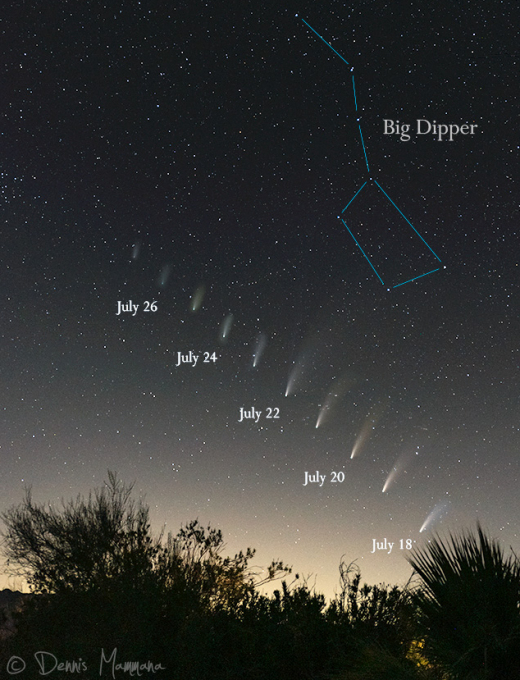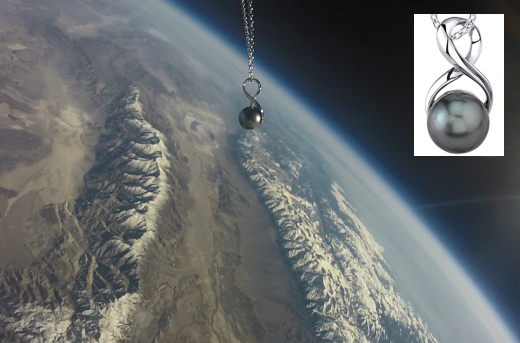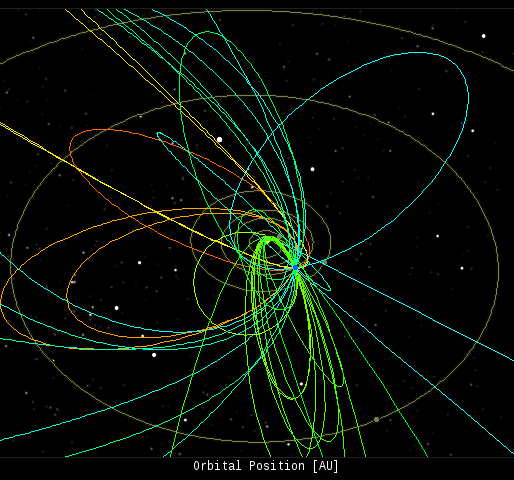 | | | Switch to: Europe, USA, New Zealand, Antarctica Credit: NOAA/Ovation  Planetary K-index Planetary K-index
Now: Kp= 1 quiet
24-hr max: Kp= 2 quiet
explanation | more data
Interplanetary Mag. Field
Btotal: 5.2 nT
Bz: -0.1 nT south
more data: ACE, DSCOVR
Updated: Today at 2345 UT  Coronal Holes: 29 Jul 20 Coronal Holes: 29 Jul 20 
Solar wind flowing from this northern coronal hole could reach Earth on Aug. 2-3. Credit: SDO/AIA  Noctilucent Clouds NLC season is underway. NASA's AIM spacecraft detected a blue cloud over the north pole on May 17th--one of the earliest starts in the spacecraft's14 year history. Check here for daily images from AIM. Switch view: Europe, USA, Asia, Polar Updated at: Noctilucent Clouds NLC season is underway. NASA's AIM spacecraft detected a blue cloud over the north pole on May 17th--one of the earliest starts in the spacecraft's14 year history. Check here for daily images from AIM. Switch view: Europe, USA, Asia, Polar Updated at:  SPACE WEATHER
NOAA Forecasts | | Updated at: 2020 Jul 29 2200 UTC FLARE | 0-24 hr | 24-48 hr | CLASS M | 01 % | 01 % | CLASS X | 01 % | 01 % |  Geomagnetic Storms: Geomagnetic Storms:
Probabilities for significant disturbances in Earth's magnetic field are given for three activity levels: active, minor storm, severe storm Updated at: 2020 Jul 29 2200 UTC Mid-latitudes | 0-24 hr | 24-48 hr | ACTIVE | 10 % | 10 % | MINOR | 01 % | 01 % | SEVERE | 01 % | 01 % | High latitudes | 0-24 hr | 24-48 hr | ACTIVE | 20 % | 20 % | MINOR | 20 % | 20 % | SEVERE | 10 % | 10 % | | | |  | | | | | | | | | | | Never miss another geomagnetic storm. Sign up for Space Weather Alerts and you'll receive a text message when auroras appear in your area. Aurora tour guides and professional astronomers use this service. Now you can, too! | | | NEW-CYCLE SUNSPOT ACTIVITY: Solar Cycle 25 is gaining strength. Today there are two new-cycle sunspots on the solar disk: AR2767 and AR2768. Both have magnetic polarities that identify them as members of Solar Cycle 25. Neither appears to pose a threat for strong solar flares, though, so the quiet of Solar Minimum continues. Aurora alerts: SMS Text. FAREWELL, COMET NEOWISE: Comet NEOWISE has faded dramatically since its close approach to Earth on July 23rd, dimming more than 10-fold. It's no longer visible to the naked eye and won't swing around the sun again for another 6,800 years. To say "farewell," Dennis Mammana of Borrego Springs, California, created this montage of the comet gliding across the evening sky: 
"I hope everyone got to see Comet NEOWISE during its recent visit," says Mammana. "It became bright enough to see easily with the unaided eye from dark rural locations but now, unfortunately, has faded into the realm of large binoculars and telescopes. I photographed it each night from July 18th to 27th. In this sequence you can see the comet changing its size and brightness as it first approaches Earth and then recedes back into the depths of our solar system, not to return to our neighborhood for nearly 68 centuries." Despite its fade, NEOWISE remains a good target for photographers with telescopes and/or sensitive digital cameras. Here's an example of what can still be seen. For more parting shots, many of them wonderful, browse the NEOWISE photo gallery: Realtime Comet NEOWISE Photo Gallery
Free: Spaceweather.com Newsletter
NOCTILUCENT CLOUDS, GOING STRONG: In a typical year, noctilucent clouds begin to fade in late July. But 2020 is not typical. "The season is still going strong," reports Robbin Gälliner, who sends this picture from Frösön, Sweden: 
"Last night (July 28th) we had a great display," says Gälliner. "I could even see the clouds reflecting in the shallow water." "My camera also picked up some faint greens and red in the northern twilight--maybe a faint aurora or just airglow," adds Gälliner. "I'm looking forward to the skies finally getting darker so aurora season can begin as well." If 2020 continues apace, Arctic sky watchers will soon be seeing auroras and NLCs side by side. Stay tuned for green mixed with electric blue--and maybe a dash of red! Realtime Noctilucent Cloud Photo Gallery
Free: Spaceweather.com Newsletter THE INFINITY BLACK PEARL: It came from Tahiti--and now it's been to the edge of space. On April 15, 2020, this genuine Black Tahitian South Sea Cultured Pearl flew to the stratosphere onboard an Earth to Sky Calculus cosmic ray balloon, soaring 107,611 feet above the Sierra Nevada mountains of central California: 
You can have it for $249.95. The students of Earth to Sky Calculus are selling these exotic space pearls to fund their cosmic ray monitoring program. Measuring 9 mm in diameter, the pearl is mounted on a 925 sterling silver infinity twist and suspended on a matching 17 inch long sterling silver chain. Each pearl comes with a greeting card showing the pendant in flight and telling the story of its journey to the edge of space. Far Out Gifts: Earth to Sky Store
All sales support hands-on STEM education
Realtime Space Weather Photo Gallery
Free: Spaceweather.com Newsletter Every night, a network of NASA all-sky cameras scans the skies above the United States for meteoritic fireballs. Automated software maintained by NASA's Meteoroid Environment Office calculates their orbits, velocity, penetration depth in Earth's atmosphere and many other characteristics. Daily results are presented here on Spaceweather.com. On July 29, 2020, the network reported 31 fireballs.
(17 sporadics, 8 Southern Delta Aquariids, 4 Perseids, 2 alpha Capricornids)  In this diagram of the inner solar system, all of the fireball orbits intersect at a single point--Earth. The orbits are color-coded by velocity, from slow (red) to fast (blue). [Larger image] [movies] Potentially Hazardous Asteroids ( PHAs) are space rocks larger than approximately 100m that can come closer to Earth than 0.05 AU. None of the known PHAs is on a collision course with our planet, although astronomers are finding new ones all the time. On July 29, 2020 there were 2037 potentially hazardous asteroids.
 | Recent & Upcoming Earth-asteroid encounters: | Asteroid | Date(UT) | Miss Distance | Velocity (km/s) | Diameter (m) | | 2020 ND | 2020-Jul-24 | 14.5 LD | 13.6 | 178 | | 2020 NN | 2020-Jul-25 | 16.3 LD | 10.1 | 42 | | 2020 OA5 | 2020-Jul-27 | 16.8 LD | 10.2 | 15 | | 2020 OO1 | 2020-Jul-27 | 1.7 LD | 7.3 | 18 | | 2020 NZ | 2020-Jul-28 | 8.2 LD | 7.8 | 31 | | 2020 OE2 | 2020-Jul-28 | 4.5 LD | 2.9 | 14 | | 2020 OY4 | 2020-Jul-28 | 0.1 LD | 12.4 | 3 | | 2020 OR4 | 2020-Jul-28 | 1.2 LD | 22.9 | 27 | | 2020 MX3 | 2020-Jul-29 | 9.4 LD | 8.5 | 63 | | 2020 OM4 | 2020-Jul-30 | 8 LD | 15.3 | 71 | | 2018 PY7 | 2020-Jul-31 | 8.9 LD | 9.5 | 16 | | 2007 RF1 | 2020-Jul-31 | 10.7 LD | 5 | 21 | | 2020 OC1 | 2020-Jul-31 | 9.6 LD | 4 | 18 | | 2020 OT4 | 2020-Jul-31 | 12.1 LD | 4.3 | 18 | | 2020 OO2 | 2020-Aug-01 | 14.9 LD | 7.8 | 29 | | 2018 BD | 2020-Aug-03 | 7.6 LD | 9.4 | 3 | | 2020 OG3 | 2020-Aug-04 | 7.1 LD | 6 | 17 | | 2009 PQ1 | 2020-Aug-05 | 10.8 LD | 13.5 | 112 | | 2020 OL4 | 2020-Aug-08 | 9.5 LD | 10.8 | 37 | | 2020 FA1 | 2020-Aug-23 | 18.4 LD | 1.9 | 20 | | 2016 AH164 | 2020-Aug-26 | 15.7 LD | 5.6 | 4 | | 2011 ES4 | 2020-Sep-01 | 0.3 LD | 8.2 | 30 | | 465824 | 2020-Sep-06 | 19.4 LD | 14 | 162 | | 2012 RM15 | 2020-Sep-12 | 14.9 LD | 9.8 | 45 | | 2017 US | 2020-Sep-13 | 17.3 LD | 5.9 | 21 | | 2014 QJ33 | 2020-Sep-18 | 11.5 LD | 8.3 | 65 | | 2017 SL16 | 2020-Sep-20 | 8.9 LD | 6.4 | 25 | Notes: LD means "Lunar Distance." 1 LD = 384,401 km, the distance between Earth and the Moon. 1 LD also equals 0.00256 AU. MAG is the visual magnitude of the asteroid on the date of closest approach. | | Cosmic Rays in the Atmosphere | SOMETHING NEW! We have developed a new predictive model of aviation radiation. It's called E-RAD--short for Empirical RADiation model. We are constantly flying radiation sensors onboard airplanes over the US and and around the world, so far collecting more than 22,000 gps-tagged radiation measurements. Using this unique dataset, we can predict the dosage on any flight over the USA with an error no worse than 15%. E-RAD lets us do something new: Every day we monitor approximately 1400 flights criss-crossing the 10 busiest routes in the continental USA. Typically, this includes more than 80,000 passengers per day. E-RAD calculates the radiation exposure for every single flight. The Hot Flights Table is a daily summary of these calculations. It shows the 5 charter flights with the highest dose rates; the 5 commercial flights with the highest dose rates; 5 commercial flights with near-average dose rates; and the 5 commercial flights with the lowest dose rates. Passengers typically experience dose rates that are 20 to 70 times higher than natural radiation at sea level. To measure radiation on airplanes, we use the same sensors we fly to the stratosphere onboard Earth to Sky Calculus cosmic ray balloons: neutron bubble chambers and X-ray/gamma-ray Geiger tubes sensitive to energies between 10 keV and 20 MeV. These energies span the range of medical X-ray machines and airport security scanners. Column definitions: (1) The flight number; (2) The maximum dose rate during the flight, expressed in units of natural radiation at sea level; (3) The maximum altitude of the plane in feet above sea level; (4) Departure city; (5) Arrival city; (6) Duration of the flight. SPACE WEATHER BALLOON DATA: Approximately once a week, Spaceweather.com and the students of Earth to Sky Calculus fly space weather balloons to the stratosphere over California. These balloons are equipped with radiation sensors that detect cosmic rays, a surprisingly "down to Earth" form of space weather. Cosmic rays can seed clouds, trigger lightning, and penetrate commercial airplanes. Furthermore, there are studies ( #1, #2, #3, #4) linking cosmic rays with cardiac arrhythmias and sudden cardiac death in the general population. Our latest measurements show that cosmic rays are intensifying, with an increase of more than 18% since 2015: 
The data points in the graph above correspond to the peak of the Regener-Pfotzer maximum, which lies about 67,000 feet above central California. When cosmic rays crash into Earth's atmosphere, they produce a spray of secondary particles that is most intense at the entrance to the stratosphere. Physicists Eric Reneger and Georg Pfotzer discovered the maximum using balloons in the 1930s and it is what we are measuring today. En route to the stratosphere, our sensors also pass through aviation altitudes: 
In this plot, dose rates are expessed as multiples of sea level. For instance, we see that boarding a plane that flies at 25,000 feet exposes passengers to dose rates ~10x higher than sea level. At 40,000 feet, the multiplier is closer to 50x. The radiation sensors onboard our helium balloons detect X-rays and gamma-rays in the energy range 10 keV to 20 MeV. These energies span the range of medical X-ray machines and airport security scanners. Why are cosmic rays intensifying? The main reason is the sun. Solar storm clouds such as coronal mass ejections (CMEs) sweep aside cosmic rays when they pass by Earth. During Solar Maximum, CMEs are abundant and cosmic rays are held at bay. Now, however, the solar cycle is swinging toward Solar Minimum, allowing cosmic rays to return. Another reason could be the weakening of Earth's magnetic field, which helps protect us from deep-space radiation. | | The official U.S. government space weather bureau | | | The first place to look for information about sundogs, pillars, rainbows and related phenomena. | | | Researchers call it a "Hubble for the sun." SDO is the most advanced solar observatory ever. | | | 3D views of the sun from NASA's Solar and Terrestrial Relations Observatory | | | Realtime and archival images of the Sun from SOHO. | | | from the NOAA Space Environment Center | | | fun to read, but should be taken with a grain of salt! Forecasts looking ahead more than a few days are often wrong. | | | from the NOAA Space Environment Center | | | the underlying science of space weather |  | To find reviews of new online casino sites in the UK try The Casino DB where there are hundreds of online casino reviews complete with bonuses and ratings. Get a bonus when playing at a new casino in the UK. The Genie got you covered! Looking for a new online casino? Try Casimpo the new site dedicated to making online casino simple, or check out the new Avenger Slots Casino and Slot Strike Casino Sites with over 500 online slots and casino games. . | | | These links help Spaceweather.com stay online. Thank you to our supporters! | | | | | | | | |  | |  |   | ©2019 Spaceweather.com. All rights reserved. This site is penned daily by Dr. Tony Phillips. | |

